
Turquoise - click a picture to buy, scroll down to read all about turquoise:

![]()
Turquoise - click a picture to buy,
scroll down to read all about turquoise:
|
|
Scroll down to read all about turquoise:
Turquoise

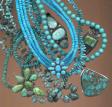
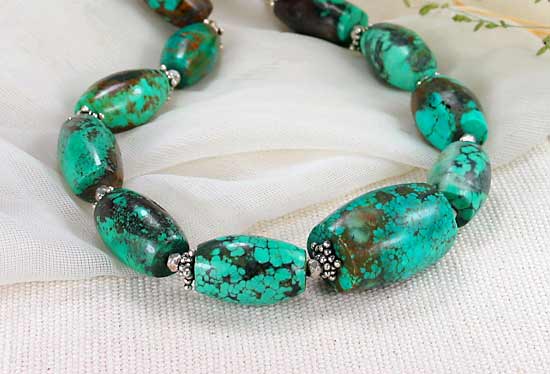
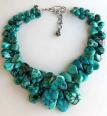
Turquoise is the gemstone for December. Turquoise is a
soft, opaque gemstone – formed by volcanic rock reacting to copper deposits
brought by water. Ranging from
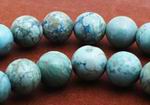
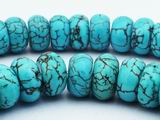 blue-green,
to yellow-green with grey, black or brown veining. Turquoise has been found in
5,000-year-old Egyptian tombs and the Tibetans used it as currency centuries
ago. North Africa and the Middle East hold large deposits, but most turquoise
today originates from Burma and is carved in China. Turquoise didn’t reach
Europe until the crusades when the name originated, meaning "Turkish stone”.
blue-green,
to yellow-green with grey, black or brown veining. Turquoise has been found in
5,000-year-old Egyptian tombs and the Tibetans used it as currency centuries
ago. North Africa and the Middle East hold large deposits, but most turquoise
today originates from Burma and is carved in China. Turquoise didn’t reach
Europe until the crusades when the name originated, meaning "Turkish stone”.
Ancient doctors thought turquoise prevented injury in accidents and ground it into a powder to cure stomach disorders, internal bleeding, and insect bites. Turquoise has always been used to protect the wearer from danger, attract wealth, and warn as a talisman or good luck charm. Some believe it will fade when danger or illness is near, or a lover is unfaithful. It is also said to protect against pollution and strengthen the body.
Turquoise is porous, so contact with liquids, oils or even perspiration should be avoided. Jewelry should be removed before washing. Turquoise is commonly impregnated with plastic, colorless oil or wax to improve color and increase durability. Untreated turquoise will eventually turn green. As genuine turquoise is expensive, reconstituted turquoise is made today. Crafted from real turquoise chips fused with other stones to cut the cost.
History of Turquoise



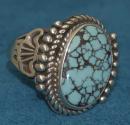
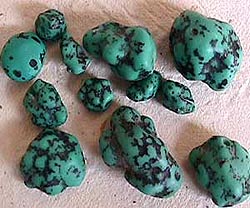
Turquoise jewelry is as popular this year as it was in
ancient times. In fact it’s hot! Its brilliant sky-blue is an all-time
favorite never going out of fashion.
In many cultures of both the Old and New World turquoise has for thousands of years been a holy stone, a good-luck-charm or talisman. A "people’s gemstone”. In Egypt, turquoise has been found in 5,000-year-old tombs. In the ancient Persian Kingdom it was originally worn around the neck or on the hand to protect against unnatural death. If the stones changed color, it warned of danger. Today it is found that turquoise changes color due to light, UV, dust, or even the ph-value of skin. Some believe it will fade if a lover is unfaithful and protect against pollution and strengthen the body.
In earlier times turquoise was thought responsible for the material wealth of its wearer. Persian philosopher Al Kazwini wrote "The hand wearing a turquoise and using it as a sealing stone will never be poor.” Turquoise decorated turbans to protect the wearer from evil, often set in a border of pearls. Others used it as a talisman on daggers, scimitars or horses. The ancient Aztecs in Northern Peru put turquoise on their ceremonial masks believing it to be holy. The North American Indians thought that the gemstone with the color of the sky has a direct connection between the sky and the lakes. The gemstone came to Europe only during the time of the crusades. Bringing its name "Turquoise”, meaning "Turkish stone”. However, it was not until Victorian time was it fashionable for Europeans to wear the stone. return to top
Turquoise’s Softness

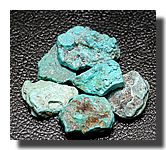
Turquoise is quite soft and its color can fade - so today
even top quality stone is waxed with a hardening treatment. It is put through a
process called stabilization in which liquid plastic is absorbed through every
pore of the stone, making it sturdier and more stable. The deeper turquoise is
mined, the softer it will be. Softness also explains why turquoise is usually
used in jewelry as nuggets, and rarely facetted. Turquoise should be protected
from cosmetics, heat and bright daylight. The gemstone does not really
appreciate sunbathing. It is recommended to clean it from time to time after
wearing with a soft cloth.
return to top
How to tell the Best
Turquoise

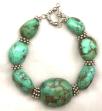
The best turquoise is like a piece of sky in your hands – a
clear light blue. This color is highly appreciated, with or without the regular
spider web veins. The quality decreases with more green and irregularities in
the spider web. The ancients preferred blue turquoise because it would not
change color - King Tut's treasures include this type that appears unchanged
today. Turquoise’s spider veins are an added-value in modern times. In the
past, highly-prized things had purity and clarity. But today we can create
perfection with machines, so we tend to value natural imperfections. It has
been said that turquoise will make you feel happy and relaxed, because it
combines the light blue of the sky with the invigorating green of the seas.
The Tibetans valued turquoise well above gold. Every Tibetan wore a piece of turquoise and it was even used for currency in many areas of Tibet. However, the true value of turquoise is in its beauty. Buy at the level you can afford, and what you see as attractive. There's no stone like turquoise, and rarely are two pieces alike. Interestingly its value will increase to the individual who wears it - it becomes a part of you.
Soon turquoise will be scarce. China, being the main supplier today, has four or five turquoise-producing regions. However, the Chinese extract huge quantities and many mines in other countries have already been depleted. High-grade turquoise is already hard to find, with not enough to satisfy the market. It is actually much rarer than diamonds or other stones like lapis. The price must increase. At one time in history superior specimens were valued by weight, more than gold. But for the time being there is still a good supply of medium-grade turquoise in China. return to top
Natural, Stabilized, or
Reconstituted Turquoise - what do I buy?
Most naturally mined turquoise is too soft for general use,
is very porous, and untreated will eventually turn green: so stabilization is
usual. This process does not alter the turquoise, just makes it usable for
jewelry. However, to cut costs, many turquoises are reconstituted today. This
means real turquoise chips are fused with other stones for economy.
Reconstituted turquoise allows more diversity of jewelry design. For example,
necklaces of tiny turquoise beads now can be made and tiny inlay is possible.
Colors will not change because the pores are sealed. Also when making heishi
beads, too much turquoise is wasted in the grinding and the resultant bead if
natural turquoise will be fragile. In all, there are many verities of natural
and treated turquoise on the market today. How do I choose? Ask yourself what
thrill are you looking for? Are you in it for the history? The lore? The color?
The natural stone? As a casual ornament? Once you identify how you want to
participate in turquoise, you can go about educating yourself in that
direction. return to
top
Color Enhancement


Color enhancement has existed for thousands of years. In
ancient times it was common to enhance turquoise by submerge it in animal or
vegetable oil. This formed a luster that lasted a long time, but with oil stains
appearing when worn. Today some stabilized turquoise is "color shot" or "color
stabilized". Color stabilized infers that it is the natural color which is
"stabilized." This is untrue, as color has been added. However, this is not so
bad, as jewelry making is art and color enhancement can improve the appearance.
Like most things, at the end of the day, the more you pay, the more natural the
stone will be.
return to top
Turquoise’s Myths


At all times turquoise was worn as protection to ward off
the influence of evil. In former times protecting riders and horses from
accidental falls, it is nowadays warn by aviators, flight staff, and those at
risk to traveling accidents. Wearing Turquoise is also recommended against
depression. The bright and happy color supposedly brings self-confidence to
subdued personalities - and is also popular as a token of friendship, bringing
faithfulness and stability to relationships.
Ancient doctors exploited the stone's medicinal potential. It was thought to prevent blindness and treat cataracts by placing perfect stones over the eyes. It was ground into a powder and rubbed on or ingested to cure stomach disorders, internal bleeding, ailments of the hip, bites and stings. Turquoise’s color could forecast good or bad, predict the weather and influence dreams. It was good for nearly every ailment including insanity. As a talisman to protect it was used in nearly every culture. Turquoise has been believed to confer foresight and fade when illness or danger is near. Aztecs and Egyptians considered it a symbol of prosperity. In India, a turquoise ring on the little finger and to look at the stone after seeing the new moon was a way to great wealth.

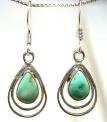
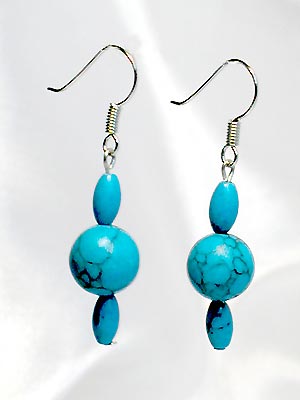
How to make a matching
Turquoise Necklace & Earrings
To make a simple turquoise choker necklace you will need
one strand of turquoise beads, a bag of tiny spacers, flexible beading wire .014
or .015 the same color as your spacers and a similar color clasp. Cut the wire
to about 22-inches. String a round spacer, a clasp bead, a spacer, and half the
clasp. Crimp the crimp bead. String a spacer followed by a turquoise bead,
then another spacer, and so on until the necklace is within 1-inch of the end of
the wire. End with a spacer and the remaining half clasp. Tighten, crimp the
crimp bead and trim the excess wire. For the matching earrings use the same
turquoise beads. Push a headpin through the beads, attach to the hook ring and
coil round to form a loop at the end.
return to top To return to the store click here